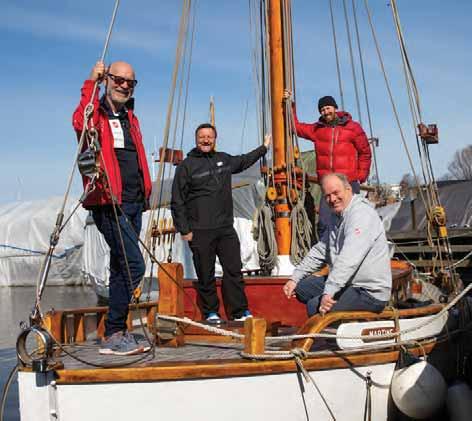
3 minute read
Feature 12 and
‘I listened and learnt a lot during these years. If I have to give something to someone, The Salvation Army is at the top of my list. When they say that the project helps people further, I believe in it. All summer I stare out to sea, which makes me relax. So it is easy to understand that people need a good environment like the sea, and that they feel good on board.’
The project is also supported by the Norwegian Directorate of Health.
‘What we see is that people not only get an experience for the day, which would be enough for us, but it affects their lives,’ says Knut Erlend. ‘People get up in the morning. They get a direction for life and a direction for the week. Now it is important to stay sober until Friday, because then they will go to Moss and sail.’
Knut Erlend is the prime mover behind the project, which is known as Frisk Seilas – literally ‘fresh sailing’. The idea came after an attempt to teach sailing at The Salvation Army’s Jeloy Folk High School.
‘How about trying sailing for people in substance abuse care?’ suggested Knut Erlend. He got the green light and, after two years, the programme has been expanded through collaborations and contacts.
The boat is relatively new, completed in 1992, but it represents a long tradition. For many decades, Colin Archer skates – named after a Norwegian naval architect from the early 20th century – saved crews far out at sea. Now this boat saves the lives of people onshore.
‘People say they get so much out of Frisk Seilas,’ says former Olympic sailor Jan Steven Johannesen, who has been part of the programme since it began. ‘They wanted to give something back. They have all acquired an ownership of Catherine Booth II. This autumn we are opening for new sailors. We know that people are in line to join.’
Surrounded by goodwill, Catherine Booth II has received free mooring from the port of Moss, and participants are free to use the large premises of Kanalen Brygge sailing association.
The goal is for the skate to be out two to three days a week. Every day, some of the boats must always be on the water. Other branches of the Army are also welcome on board. The idea is that families with children and participants in family camps can join in the sailing.
‘We want the most possible use of the boat,’ says Frode. ‘Here, people have more space and the opportunity to be together at a different pace. We see that people are growing because of the opportunities they have on board.’
The name Catherine Booth II is not random. From 1900 to 1931, The Salvation Army had its own lifeboat, RS 37 Catherine Booth. The skate went into service along the coast in Lofoten and western Finnmark. Statistics show that Catherine Booth towed ashore 1,767 boats with 4,798 men, of whom 99 were rescued from a situation that would have ended in certain death.
The ship was out regardless of the weather and the rescue crew were known for their toughness. When the storms were at their worst, they tied the helmsman to the mast so that he would not fall overboard.
They also had another purpose: in the harbours they held open-air worship meetings where they shared with people about Jesus.
The boat crashed in 1930 and, though quickly repaired, the operation became too expensive, and The Salvation Army transferred the boat to the Rescue Society. It went there for eight years before being sold to Madeira, where it was probably dismantled in the 1950s.
This new version should last a long time.

Based on an article by Marit DehliJohannesen originally published in Krigsropet and All the World





